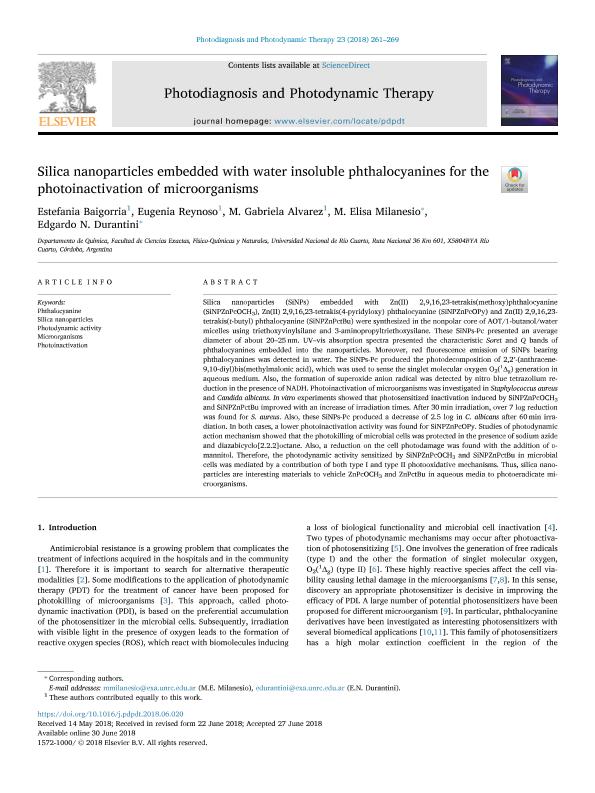Artículo
Silica nanoparticles embedded with water insoluble phthalocyanines for the photoinactivation of microorganisms
Baigorria, Estefanía ; Reynoso, Eugenia
; Reynoso, Eugenia ; Alvarez, María Gabriela
; Alvarez, María Gabriela ; Milanesio, María Elisa
; Milanesio, María Elisa ; Durantini, Edgardo Néstor
; Durantini, Edgardo Néstor
 ; Reynoso, Eugenia
; Reynoso, Eugenia ; Alvarez, María Gabriela
; Alvarez, María Gabriela ; Milanesio, María Elisa
; Milanesio, María Elisa ; Durantini, Edgardo Néstor
; Durantini, Edgardo Néstor
Fecha de publicación:
09/2018
Editorial:
Elsevier Science
Revista:
Photodiagnosis Photodynamic Therapy
ISSN:
1572-1000
Idioma:
Inglés
Tipo de recurso:
Artículo publicado
Clasificación temática:
Resumen
Silica nanoparticles (SiNPs) embedded with Zn(II) 2,9,16,23-tetrakis(methoxy)phthalocyanine (SiNPZnPcOCH3), Zn(II) 2,9,16,23-tetrakis(4-pyridyloxy) phthalocyanine (SiNPZnPcOPy) and Zn(II) 2,9,16,23-tetrakis(t-butyl) phthalocyanine (SiNPZnPctBu) were synthesized in the nonpolar core of AOT/1-butanol/water micelles using triethoxyvinylsilane and 3-aminopropyltriethoxysilane. These SiNPs-Pc presented an average diameter of about 20–25 nm. UV–vis absorption spectra presented the characteristic Soret and Q bands of phthalocyanines embedded into the nanoparticles. Moreover, red fluorescence emission of SiNPs bearing phthalocyanines was detected in water. The SiNPs-Pc produced the photodecomposition of 2,2′-(anthracene-9,10-diyl)bis(methylmalonic acid), which was used to sense the singlet molecular oxygen O2(1Δg) generation in aqueous medium. Also, the formation of superoxide anion radical was detected by nitro blue tetrazolium reduction in the presence of NADH. Photoinactivation of microorganisms was investigated in Staphylococcus aureus and Candida albicans. In vitro experiments showed that photosensitized inactivation induced by SiNPZnPcOCH3 and SiNPZnPctBu improved with an increase of irradiation times. After 30 min irradiation, over 7 log reduction was found for S. aureus. Also, these SiNPs-Pc produced a decrease of 2.5 log in C. albicans after 60 min irradiation. In both cases, a lower photoinactivation activity was found for SiNPZnPcOPy. Studies of photodynamic action mechanism showed that the photokilling of microbial cells was protected in the presence of sodium azide and diazabicyclo[2.2.2]octane. Also, a reduction on the cell photodamage was found with the addition of D-mannitol. Therefore, the photodynamic activity sensitized by SiNPZnPcOCH3 and SiNPZnPctBu in microbial cells was mediated by a contribution of both type I and type II photooxidative mechanisms. Thus, silica nanoparticles are interesting materials to vehicle ZnPcOCH3 and ZnPctBu in aqueous media to photoeradicate microorganisms.
Archivos asociados
Licencia
Identificadores
Colecciones
Articulos(CCT - CORDOBA)
Articulos de CTRO.CIENTIFICO TECNOL.CONICET - CORDOBA
Articulos de CTRO.CIENTIFICO TECNOL.CONICET - CORDOBA
Citación
Baigorria, Estefanía; Reynoso, Eugenia; Alvarez, María Gabriela; Milanesio, María Elisa; Durantini, Edgardo Néstor; Silica nanoparticles embedded with water insoluble phthalocyanines for the photoinactivation of microorganisms; Elsevier Science; Photodiagnosis Photodynamic Therapy; 23; 9-2018; 261-269
Compartir
Altmétricas



